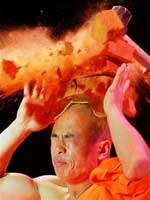|
China kung fu temple switches on to reality TV
(Agencies)
Updated: 2005-11-21 09:27

Song Atmin, who is trained in the Shaolin martial arts, has
bricks smashed on his head in Scotland, August 11, 2005. China's ancient
Shaolin Temple, made famous in the West by Grasshopper in the 1970s 'Kung
Fu' television series, is entering the age of reality TV with a show its
own. [Reuters] | China's ancient Shaolin
Temple, made famous in the West by Grasshopper in the 1970s "Kung Fu" television
series, is entering the age of reality TV with a show its own.
"Chinese Kung Fu Star Search" will invite viewers to vote for their favourite
martial arts masters by text messages or through the Internet after each
episode, due to hit living rooms across China in March, Xinhua news agency said
on Friday.
"Regardless of nationality, skin colour or style, anyone who practises
Chinese kung fu is welcome to take part," Xinhua said.
"But all contestants must be men and Shaolin monks are not allowed to
participate."
The eight-month contest is aiming to knock the "Inner Mongolian Cow Sour
Yoghurt Supergirl" show from top spot in China's ratings.
More than 400 million of China's 1.3 billion people tuned in to August's
final round of the "Supergirl" competition, a Chinese version of the "American
Idol" show.
In the Shaolin show, judges and viewers will rank contestants by virtue, kung
fu and artistry until they settle on a final 108, the same number as the
rebellious heroes from the classic Chinese novel, "Outlaws of the Marsh".
The finalists would then get the chance to perform alongside "top
international actors" in a big-budget movie and television series based on true
stories from the 1,500-year-old temple in central Henan province, Xinhua
said.
It is all part of abbot Shi Yongxin's efforts to promote the temple, which
has inspired countless movies in China and Hong Kong but is perhaps best known
in the West as the training grounds of David Carradine's main character, Kwai
Chang Caine, in "Kung Fu".
Shi has been trying to protect the Shaolin name by applying for international
trademarks and to update the image and facilities of the once-secretive temple,
now a popular draw for Chinese and foreign tourists.
|

